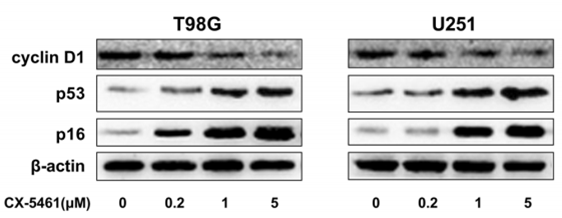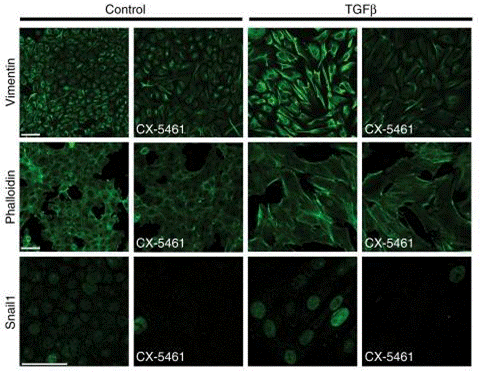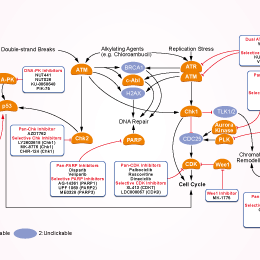
- Bioactive Compounds
- By Signaling Pathways
- PI3K/Akt/mTOR
- Epigenetics
- Methylation
- Immunology & Inflammation
- Protein Tyrosine Kinase
- Angiogenesis
- Apoptosis
- Autophagy
- ER stress & UPR
- JAK/STAT
- MAPK
- Cytoskeletal Signaling
- Cell Cycle
- TGF-beta/Smad
- DNA Damage/DNA Repair
- Compound Libraries
- Popular Compound Libraries
- Customize Library
- Clinical and FDA-approved Related
- Bioactive Compound Libraries
- Inhibitor Related
- Natural Product Related
- Metabolism Related
- Cell Death Related
- By Signaling Pathway
- By Disease
- Anti-infection and Antiviral Related
- Neuronal and Immunology Related
- Fragment and Covalent Related
- FDA-approved Drug Library
- FDA-approved & Passed Phase I Drug Library
- Preclinical/Clinical Compound Library
- Bioactive Compound Library-I
- Bioactive Compound Library-Ⅱ
- Kinase Inhibitor Library
- Express-Pick Library
- Natural Product Library
- Human Endogenous Metabolite Compound Library
- Alkaloid Compound LibraryNew
- Angiogenesis Related compound Library
- Anti-Aging Compound Library
- Anti-alzheimer Disease Compound Library
- Antibiotics compound Library
- Anti-cancer Compound Library
- Anti-cancer Compound Library-Ⅱ
- Anti-cancer Metabolism Compound Library
- Anti-Cardiovascular Disease Compound Library
- Anti-diabetic Compound Library
- Anti-infection Compound Library
- Antioxidant Compound Library
- Anti-parasitic Compound Library
- Antiviral Compound Library
- Apoptosis Compound Library
- Autophagy Compound Library
- Calcium Channel Blocker LibraryNew
- Cambridge Cancer Compound Library
- Carbohydrate Metabolism Compound LibraryNew
- Cell Cycle compound library
- CNS-Penetrant Compound Library
- Covalent Inhibitor Library
- Cytokine Inhibitor LibraryNew
- Cytoskeletal Signaling Pathway Compound Library
- DNA Damage/DNA Repair compound Library
- Drug-like Compound Library
- Endoplasmic Reticulum Stress Compound Library
- Epigenetics Compound Library
- Exosome Secretion Related Compound LibraryNew
- FDA-approved Anticancer Drug LibraryNew
- Ferroptosis Compound Library
- Flavonoid Compound Library
- Fragment Library
- Glutamine Metabolism Compound Library
- Glycolysis Compound Library
- GPCR Compound Library
- Gut Microbial Metabolite Library
- HIF-1 Signaling Pathway Compound Library
- Highly Selective Inhibitor Library
- Histone modification compound library
- HTS Library for Drug Discovery
- Human Hormone Related Compound LibraryNew
- Human Transcription Factor Compound LibraryNew
- Immunology/Inflammation Compound Library
- Inhibitor Library
- Ion Channel Ligand Library
- JAK/STAT compound library
- Lipid Metabolism Compound LibraryNew
- Macrocyclic Compound Library
- MAPK Inhibitor Library
- Medicine Food Homology Compound Library
- Metabolism Compound Library
- Methylation Compound Library
- Mouse Metabolite Compound LibraryNew
- Natural Organic Compound Library
- Neuronal Signaling Compound Library
- NF-κB Signaling Compound Library
- Nucleoside Analogue Library
- Obesity Compound Library
- Oxidative Stress Compound LibraryNew
- Plant Extract Library
- Phenotypic Screening Library
- PI3K/Akt Inhibitor Library
- Protease Inhibitor Library
- Protein-protein Interaction Inhibitor Library
- Pyroptosis Compound Library
- Small Molecule Immuno-Oncology Compound Library
- Mitochondria-Targeted Compound LibraryNew
- Stem Cell Differentiation Compound LibraryNew
- Stem Cell Signaling Compound Library
- Natural Phenol Compound LibraryNew
- Natural Terpenoid Compound LibraryNew
- TGF-beta/Smad compound library
- Traditional Chinese Medicine Library
- Tyrosine Kinase Inhibitor Library
- Ubiquitination Compound Library
-
Cherry Picking
You can personalize your library with chemicals from within Selleck's inventory. Build the right library for your research endeavors by choosing from compounds in all of our available libraries.
Please contact us at [email protected] to customize your library.
You could select:
- Antibodies
- Bioreagents
- qPCR
- 2x SYBR Green qPCR Master Mix
- 2x SYBR Green qPCR Master Mix(Low ROX)
- 2x SYBR Green qPCR Master Mix(High ROX)
- Protein Assay
- Protein A/G Magnetic Beads for IP
- Anti-Flag magnetic beads
- Anti-Flag Affinity Gel
- Anti-Myc magnetic beads
- Anti-HA magnetic beads
- Magnetic Separator
- Poly DYKDDDDK Tag Peptide lyophilized powder
- Protease Inhibitor Cocktail
- Protease Inhibitor Cocktail (EDTA-Free, 100X in DMSO)
- Phosphatase Inhibitor Cocktail (2 Tubes, 100X)
- Cell Biology
- Cell Counting Kit-8 (CCK-8)
- Animal Experiment
- Mouse Direct PCR Kit (For Genotyping)
- New Products
- Contact Us
Pidnarulex (CX-5461)
Pidnarulex (CX-5461) is an inhibitor of rRNA synthesis, selectively inhibits Pol I-driven transcription of rRNA with IC50 of 142 nM in HCT-116, A375, and MIA PaCa-2 cells, has no effect on Pol II, and possesses 250- to 300-fold selectivity for inhibition of rRNA transcription versus DNA replication and protein translation.

Pidnarulex (CX-5461) Chemical Structure
CAS No. 1138549-36-6
Purity & Quality Control
Batch:
Purity:
99.07%
99.07
Pidnarulex (CX-5461) Related Products
| Related Targets | tRNA synthetase RdRp DNA synthesis helicase ribonucleotide reductase | Click to Expand |
|---|---|---|
| Related Products | SCR7 Favipiravir (T-705) RK-33 Carmofur Triapine (3-AP) B02 BMH-21 YK-4-279 Bergapten Tegafur (FT-207) Azaguanine-8 Halofuginone Adenine HCl Mizoribine Cyclocytidine HCl Thymidine APX-3330 Nedaplatin 6-Thio-dG Flupirtine maleate JH-RE-06 Pritelivir (BAY 57-1293) TK216 Amenamevir Madrasin Tubercidin BC-LI-0186 CRT0044876 PFM01 Adenine ML216 | Click to Expand |
| Related Compound Libraries | FDA-approved Drug Library Natural Product Library Apoptosis Compound Library DNA Damage/DNA Repair compound Library Cell Cycle compound library | Click to Expand |
Signaling Pathway
Cell Data
| Cell Lines | Assay Type | Concentration | Incubation Time | Formulation | Activity Description | PMID |
|---|---|---|---|---|---|---|
| MNNG | Cell viability assay | 72 h | IC50=0.5-1.5 µM | 27729807 | ||
| U2-OS | Cell viability assay | 72 h | IC50=0.5-1.5 µM | 27729807 | ||
| RS4;11 | Proliferation assay | 250 nM | 24 h | time dependent decrease in proliferation relative to their DMSO treated controls | 26472108 | |
| SEM | Proliferation assay | 250 nM | 24 h | time dependent decrease in proliferation relative to their DMSO treated controls | 26472108 | |
| KOPN-8 | Proliferation assay | 250 nM | 24 h | time dependent decrease in proliferation relative to their DMSO treated controls | 26472108 | |
| NALM-6 | Proliferation assay | 250 nM | 24 h | time dependent decrease in proliferation relative to their DMSO treated controls | 26472108 | |
| NB-EBc1 | qHTS assay | qHTS of pediatric cancer cell lines to identify multiple opportunities for drug repurposing: Primary screen for NB-EBc1 cells | 29435139 | |||
| Click to View More Cell Line Experimental Data | ||||||
Biological Activity
| Description | Pidnarulex (CX-5461) is an inhibitor of rRNA synthesis, selectively inhibits Pol I-driven transcription of rRNA with IC50 of 142 nM in HCT-116, A375, and MIA PaCa-2 cells, has no effect on Pol II, and possesses 250- to 300-fold selectivity for inhibition of rRNA transcription versus DNA replication and protein translation. | ||
|---|---|---|---|
| Targets |
|
| In vitro | ||||
| In vitro | CX-5461 is found to selectively inhibit rRNA synthesis (Pol I IC50=142 nM; Pol II IC50 > 25 μM; selectivity ~200-fold) in the HCT-116 cells. Selective inhibition of rRNA synthesis by CX-5461 is confirmed in two other human solid tumor cell lines; melanoma A375 (Pol I IC50 = 113 nM; Pol II IC50 > 25 μM) and pancreatic carcinoma MIA PaCa-2 (Pol I IC50=54 nM; Pol II IC50 ~25 mM). CX-5461 possesses 250- to 300-fold selectivity for inhibition of rRNA transcription versus DNA replication and protein translation. CX-5461 exhibits broad antiproliferative potency in a panel of cancer cell lines in human cancer cell lines, but has minimal effect on viability of nontransformed human cells. The median EC50 across all tested cell lines is 147 nM, yet all normal cell lines have EC50 values of approximately 5, 000 nM. Evaluation of the antiproliferative dose response for HCT-116, A375, and MIA PaCa-2 cell lines yield EC50 values of 167, 58, and 74 nM. CX-5461 induces autophagy and senescence in solid tumor cancer cells, rather than apoptosis, through a p53-independent process. [1] |
|||
|---|---|---|---|---|
| Kinase Assay | Pol I and Pol II Transcription Assay | |||
| Two short-lived RNA transcripts (half-lives ~20-30 minutes), one produced by Pol I and another by Pol II, are quantitated by qRT-PCR as a measure of CX-5461-related effects on transcription. The 45S pre-rRNA served as the Pol I transcript and the mRNA for the protooncogene c-myc served as the comparator Pol II transcript. Both Pol I and Pol II transcription are known to be affected by general cellular stress. To minimize the potential effects of such stress, cellsare exposed to test agents for only a short period of time (2 hours). This is sufficient time for these transcripts to be reduced by greater than 90% if CX-5461 affects their synthesis. | ||||
| Cell Research | Cell lines | panel of cancer and normal cell lines | ||
| Concentrations | 0-2 μM | |||
| Incubation Time | 96 hours | |||
| Method | Cells are plated on 96-well plates and treated the next day with dose response of CX-5461 for 96 hours. Cell viability is determined using Alamar Blue and CyQUANT assays |
|||
| Experimental Result Images | Methods | Biomarkers | Images | PMID |
| Western blot | Cyclin D1 / p53 / p16 53BP1 / γ-H2AX / p-ATM Bcl-2 / Bax / Caspase3 cleaved PARP / cleaved Caspase-9 / cleaved caspase-3 p-AMPK / AMPK / p-mTOR / mTOR EG5 / Histone H3 / p-Histone H3 (S10) |

|
29631594 | |
| Immunofluorescence | Vimentin / Phalloidin / Snail1 Rictor / Calnexin Fibrillarin LC3 γH2AX / 53BP1 / RPA / RAD51 chromosome / telomere F-actin / Aurora B |

|
31068593 | |
| Growth inhibition assay | Cell viability |

|
26061708 | |
| In Vivo | ||
| In vivo | CX-5461 is orally bioavailable and demonstrates in vivo antitumor activity against human solid tumors in murine xenograft models. CX-5461 demonstrates significant MIA PaCa-2 TGI with TGI equal to 69% on day 31. Likewise, CX- 5461 demonstrates significant A375 TGI with TGI equal to 79% on day 32. [1] |
|
|---|---|---|
| Animal Research | Animal Models | 5 × 106 MIA Paca-2 and A375 cancer cells are subcutaneously inoculated in the right flank of 5- to 6- week-old female athymic mice |
| Dosages | 50 mg/kg | |
| Administration | CX-5461 is administered orally once daily or every 3 days. | |
| NCT Number | Recruitment | Conditions | Sponsor/Collaborators | Start Date | Phases |
|---|---|---|---|---|---|
| NCT02719977 | Completed | Cancer |
Canadian Cancer Trials Group|Senhwa Biosciences Inc.|Stand Up To Cancer |
June 13 2016 | Phase 1 |
Chemical Information & Solubility
| Molecular Weight | 513.61 | Formula | C27H27N7O2S |
| CAS No. | 1138549-36-6 | SDF | Download Pidnarulex (CX-5461) SDF |
| Smiles | CC1=CN=C(C=N1)CNC(=O)C2=C3N(C4=CC=CC=C4S3)C5=C(C2=O)C=CC(=N5)N6CCCN(CC6)C | ||
| Storage (From the date of receipt) | |||
|
In vitro |
DMSO : Insoluble ( Moisture-absorbing DMSO reduces solubility. Please use fresh DMSO.) Water : Insoluble Ethanol : Insoluble |
Molecular Weight Calculator |
|
In vivo Add solvents to the product individually and in order. |
In vivo Formulation Calculator |
||||
Preparing Stock Solutions
Molarity Calculator
In vivo Formulation Calculator (Clear solution)
Step 1: Enter information below (Recommended: An additional animal making an allowance for loss during the experiment)
mg/kg
g
μL
Step 2: Enter the in vivo formulation (This is only the calculator, not formulation. Please contact us first if there is no in vivo formulation at the solubility Section.)
% DMSO
%
% Tween 80
% ddH2O
%DMSO
%
Calculation results:
Working concentration: mg/ml;
Method for preparing DMSO master liquid: mg drug pre-dissolved in μL DMSO ( Master liquid concentration mg/mL, Please contact us first if the concentration exceeds the DMSO solubility of the batch of drug. )
Method for preparing in vivo formulation: Take μL DMSO master liquid, next addμL PEG300, mix and clarify, next addμL Tween 80, mix and clarify, next add μL ddH2O, mix and clarify.
Method for preparing in vivo formulation: Take μL DMSO master liquid, next add μL Corn oil, mix and clarify.
Note: 1. Please make sure the liquid is clear before adding the next solvent.
2. Be sure to add the solvent(s) in order. You must ensure that the solution obtained, in the previous addition, is a clear solution before proceeding to add the next solvent. Physical methods such
as vortex, ultrasound or hot water bath can be used to aid dissolving.
Tech Support
Answers to questions you may have can be found in the inhibitor handling instructions. Topics include how to prepare stock solutions, how to store inhibitors, and issues that need special attention for cell-based assays and animal experiments.
Tel: +1-832-582-8158 Ext:3
If you have any other enquiries, please leave a message.
* Indicates a Required Field
Frequently Asked Questions
Question 1:
I want to make it for further in vivo treatment. I
Answer:
The solubility of this compound is poor in common vehicles. It can be dissolved in DMF at 3 mg/ml with warming.
Tags: buy Pidnarulex (CX-5461) | Pidnarulex (CX-5461) supplier | purchase Pidnarulex (CX-5461) | Pidnarulex (CX-5461) cost | Pidnarulex (CX-5461) manufacturer | order Pidnarulex (CX-5461) | Pidnarulex (CX-5461) distributor







































